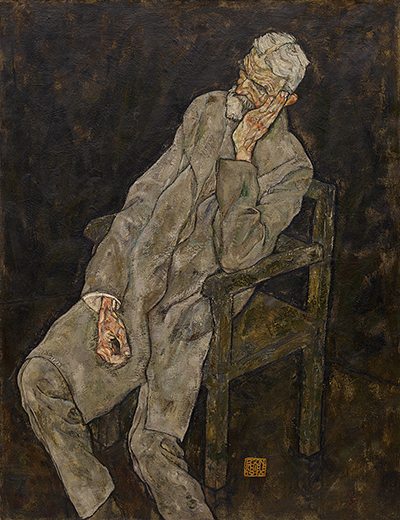Johann Harms: Portrait of an Old Man - this delightful portrait was produced by Egon Schiele at a time when he was fully established within his career for the first time.
This family portrait, originally created as an oil and wax on canvas, was painted by Egon Schiele in 1916 just two years before the artist's own death from Spanish flu. This painting is considered to be the first of Schiele's most "painterly portraits" and a clear departure from his graphic and often shocking, sexual images. The subject in the painting is Schiele's 73-year-old father-in-law, Johann Harms. Johann Harms was a retired machinist on the Austrian Railway. Schiele was fond of Johann and when his father in law died in 1917 he also made a death mask of him. The chair in the painting is interesting. It was used a number of times as a prop for Schiele's subjects. The upright nature of the chair made Schiele's subjects sit forward and tended to enlarge the contours of the subject's body.
Although in this picture, it is the position of the old man Johann Harms, that is most interesting. He appears to be sliding forward on the seat and the viewer is unsure if he is asleep or simply thinking. Together with the rather dark and autumnal colour palette used in the painting, it is clear that the old man is in his autumn years. There is a feeling of serenity about the picture and some have commented that it is Schiele's sympathy for the old man that is depicted here. It is certainly a contrast to his more caricature-like and sexually explicit pictures. Here, in this portrait of Johann Harms, the viewer can see the full depth and range of Schiele's talents and appreciate the painter's achievements in his short but intriguing career.
This painting can be found in the collection of the Guggenheim Museum. It came right at the end of the artist's career, and represents a maturity within his work which belied his age - he was still only in his mid-twenties at this stage but was working very productively, leaving behind hundreds of artworks by the time of his early demise from Spanish Flu. The loss of his wife and due baby just a few days earlier caps off an awful end to a life which gave so much to the art world and left behind an Expressionist style that would inspire many others who were around that time, or who followed on in the decades that followed. There have, sadly, been a number of other historical artists who have died young, but somehow their talent has still lasted the test of time.




